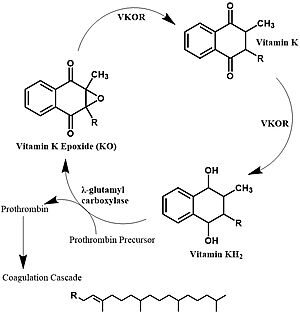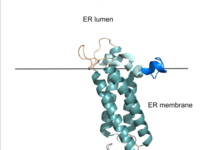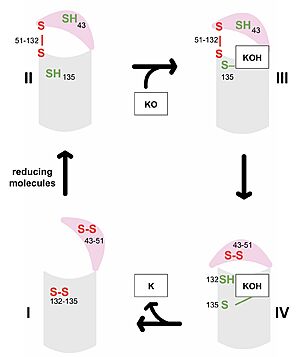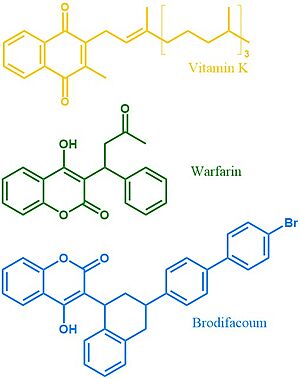Sandbox Reserved 1725
From Proteopedia
(Difference between revisions)
| Line 1: | Line 1: | ||
–{{Template:CH462_Biochemistry_II_2022}}<!-- PLEASE ADD YOUR CONTENT BELOW HERE --> | –{{Template:CH462_Biochemistry_II_2022}}<!-- PLEASE ADD YOUR CONTENT BELOW HERE --> | ||
==Vitamin K Epoxide Reductase== | ==Vitamin K Epoxide Reductase== | ||
| - | <StructureSection load='1stp' size='340' side='right' caption='Overall Structure of Vitamin K Epoxide Reductase' scene='90/904329/Vkoroverallblue/ | + | <StructureSection load='1stp' size='340' side='right' caption='Overall Structure of Vitamin K Epoxide Reductase' scene='90/904329/Vkoroverallblue/5'> |
== Introduction == | == Introduction == | ||
| Line 14: | Line 14: | ||
=== Structural Overview === | === Structural Overview === | ||
VKOR consists of four <scene name='90/904330/Transmembranehelices1/5'>transmembrane helices</scene> embedded in the endoplasmic reticulum membrane. Helices one and two are <scene name='90/904330/Betahairpin2/3'>connected</scene> by <b><span class="text-brown">Loop 1</span></b> and the <b><span class="text-orange">beta hairpin</span></b> region which contains two of the active cysteines, C43 and C51; these cysteines, along with C132 and C135, are essential for reduction and structural changes discussed in the next section<ref name="Liu">PMID:33154105</ref>. VKOR also has a <scene name='90/904330/Capdomain/2'>cap domain</scene> consisting of a <b><span class="text-blue">helix</span></b>, <b><span class="text-lightmagenta">loop</span></b>, and <b><span class="text-olive">anchor</span></b>. The anchor serves to attach the cap domain to the ER membrane for stabilization<ref name="Liu">PMID:33154105</ref>. The loop helps stabilize one of the catalytic amino acids, Asn80<ref name="Liu">PMID:33154105</ref>. The helix is involved in stabilization of certain disulfide bonds and structural changes as part of the catalytic cycle discussed below<ref name="Liu">PMID:33154105</ref>. | VKOR consists of four <scene name='90/904330/Transmembranehelices1/5'>transmembrane helices</scene> embedded in the endoplasmic reticulum membrane. Helices one and two are <scene name='90/904330/Betahairpin2/3'>connected</scene> by <b><span class="text-brown">Loop 1</span></b> and the <b><span class="text-orange">beta hairpin</span></b> region which contains two of the active cysteines, C43 and C51; these cysteines, along with C132 and C135, are essential for reduction and structural changes discussed in the next section<ref name="Liu">PMID:33154105</ref>. VKOR also has a <scene name='90/904330/Capdomain/2'>cap domain</scene> consisting of a <b><span class="text-blue">helix</span></b>, <b><span class="text-lightmagenta">loop</span></b>, and <b><span class="text-olive">anchor</span></b>. The anchor serves to attach the cap domain to the ER membrane for stabilization<ref name="Liu">PMID:33154105</ref>. The loop helps stabilize one of the catalytic amino acids, Asn80<ref name="Liu">PMID:33154105</ref>. The helix is involved in stabilization of certain disulfide bonds and structural changes as part of the catalytic cycle discussed below<ref name="Liu">PMID:33154105</ref>. | ||
| + | |||
| + | === Author's Note === | ||
| + | In order to deduce VKOR structures, Liu <ref name="Liu">PMID:33154105</ref> and colleagues used various strategies worthy of note. They incorporated a barrel-like domain that is not part of the catalytic VKOR protein to help with stability during experimentation. In some conformations, a catalytic cysteine was mutated to serine to force the reaction to stop with VKOR in that certain conformation. Also, due to stability issues, some of Liu's experiments used human VKOR and others used VKOR of ''Takifugu rubripes'' which is similar to humans. The barrel domain has been removed here and the amino acids renumbered to more closely match the published numbering in the referenced article <ref name="Liu">PMID:33154105</ref>. | ||
=== Active Site === | === Active Site === | ||
| Line 37: | Line 40: | ||
There are around 30 known missense mutations that lead to warfarin resistance in patients, but these mutations do not affect Vitamin K binding for reasons which are not yet fully understood. Such patients require higher doses of warfarin to reach therapeutic level or require a different anticoagulant drug. <ref name="Wu">PMID:29743176</ref> | There are around 30 known missense mutations that lead to warfarin resistance in patients, but these mutations do not affect Vitamin K binding for reasons which are not yet fully understood. Such patients require higher doses of warfarin to reach therapeutic level or require a different anticoagulant drug. <ref name="Wu">PMID:29743176</ref> | ||
| - | ==== Warfarin Dependence on Catalytic Cysteines ==== | ||
| - | The anticoagulant [https://en.wikipedia.org/wiki/Warfarin warfarin] works by inhibiting VKOR (See "Medical Relevance"). Warfarin binding also depends on the catalytic cysteines. Warfarin is able to bind to the fully oxidized open form of VKOR as shown in <scene name='90/904329/Cat_cycle_i/1'>step I</scene>. Once Warfarin binds, VKOR is considered to be in a closed conformation since the substrate cannot enter, despite the lack of disulfide bridge changes. Warfarin can also bind to the partially oxidized form of VKOR as shown in <scene name='90/904329/Cat_cycle_2/1'>step II</scene>. | ||
===Superwarfarins=== | ===Superwarfarins=== | ||
Revision as of 19:24, 16 April 2022
–
| This Sandbox is Reserved from February 28 through September 1, 2022 for use in the course CH462 Biochemistry II taught by R. Jeremy Johnson at the Butler University, Indianapolis, USA. This reservation includes Sandbox Reserved 1700 through Sandbox Reserved 1729. |
To get started:
More help: Help:Editing |
Vitamin K Epoxide Reductase
| |||||||||||
References
- ↑ 1.0 1.1 Stafford DW. The vitamin K cycle. J Thromb Haemost. 2005 Aug;3(8):1873-8. doi: 10.1111/j.1538-7836.2005.01419.x. PMID:16102054 doi:http://dx.doi.org/10.1111/j.1538-7836.2005.01419.x
- ↑ 2.0 2.1 Blanchard RA, Furie BC, Jorgensen M, Kruger SF, Furie B. Acquired vitamin K-dependent carboxylation deficiency in liver disease. N Engl J Med. 1981 Jul 30;305(5):242-8. doi: 10.1056/NEJM198107303050502. PMID:6165889 doi:http://dx.doi.org/10.1056/NEJM198107303050502
- ↑ Swanson JC, Suttie JW. Vitamin K dependent in vitro production of prothrombin. Biochemistry. 1982 Nov 9;21(23):6011-8. doi: 10.1021/bi00266a044. PMID:6758841 doi:http://dx.doi.org/10.1021/bi00266a044
- ↑ 4.00 4.01 4.02 4.03 4.04 4.05 4.06 4.07 4.08 4.09 4.10 4.11 Liu S, Li S, Shen G, Sukumar N, Krezel AM, Li W. Structural basis of antagonizing the vitamin K catalytic cycle for anticoagulation. Science. 2020 Nov 5. pii: science.abc5667. doi: 10.1126/science.abc5667. PMID:33154105 doi:http://dx.doi.org/10.1126/science.abc5667
- ↑ 5.0 5.1 Patel S, Singh R, Preuss CV, Patel N. Warfarin PMID:29261922
- ↑ Wu S, Chen X, Jin DY, Stafford DW, Pedersen LG, Tie JK. Warfarin and vitamin K epoxide reductase: a molecular accounting for observed inhibition. Blood. 2018 Aug 9;132(6):647-657. doi: 10.1182/blood-2018-01-830901. Epub 2018, May 9. PMID:29743176 doi:http://dx.doi.org/10.1182/blood-2018-01-830901
- ↑ 7.0 7.1 Chong YK, Mak TW. Superwarfarin (Long-Acting Anticoagulant Rodenticides) Poisoning: from Pathophysiology to Laboratory-Guided Clinical Management. Clin Biochem Rev. 2019 Nov;40(4):175-185. doi: 10.33176/AACB-19-00029. PMID:31857739 doi:http://dx.doi.org/10.33176/AACB-19-00029
Student Contributors
Izabella Jordan, Emma Varness




